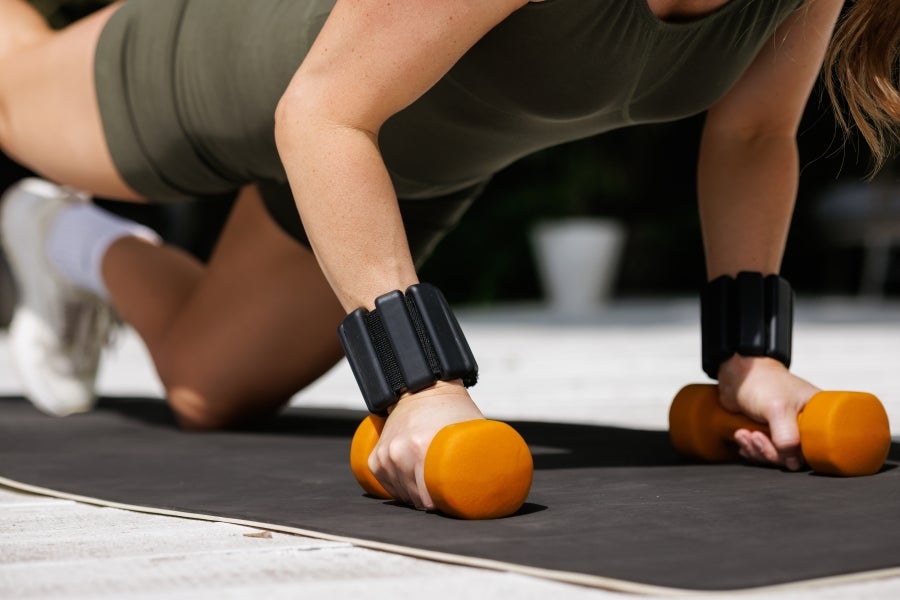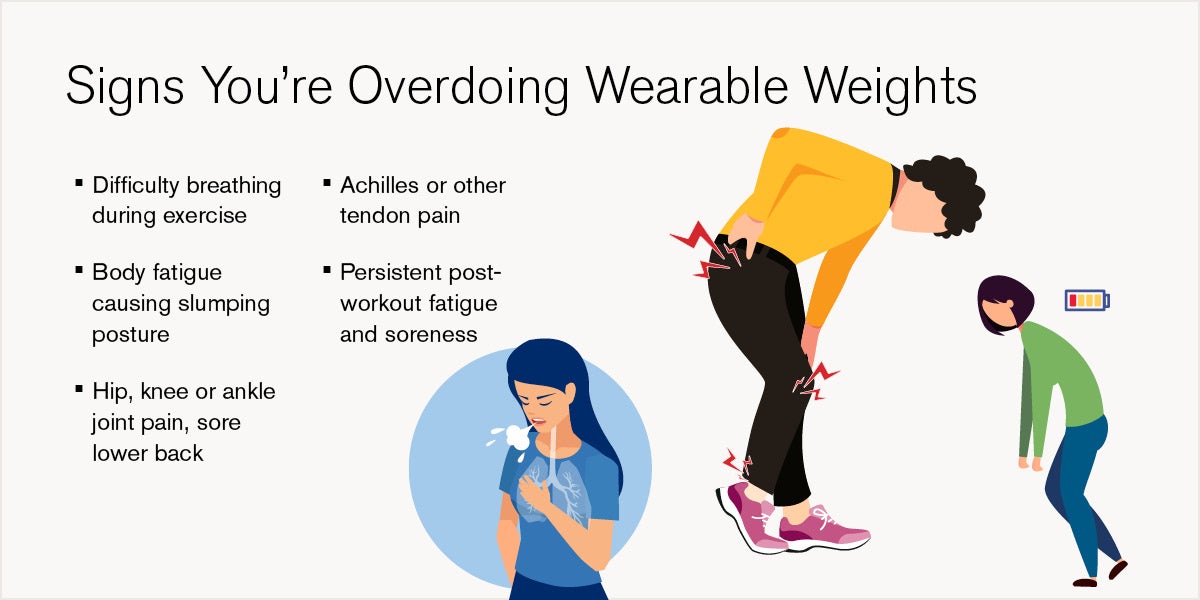Maximize Your Workout: A Guide to Weighted Vests, Wrist Weights and Ankle Weights
July 14, 2025
Categories: Sports Medicine, Orthopaedics
By Richard James Lawley, MD, Orthopaedics
 Wearable weights have seen a surge in popularity, especially as people look for new ways to enhance their workouts at home, at the gym, or even during everyday activities. But while these tools offer promising rewards for strength, endurance, and bone health, it's important to understand how they work, when they should be added to your workout routine, and how to reduce your risk for injury.
Wearable weights have seen a surge in popularity, especially as people look for new ways to enhance their workouts at home, at the gym, or even during everyday activities. But while these tools offer promising rewards for strength, endurance, and bone health, it's important to understand how they work, when they should be added to your workout routine, and how to reduce your risk for injury.
What is a weighted vest?
Weighted wearables are fitness accessories designed to add external resistance to your body during exercise. This resistance makes your muscles work harder, leading to greater strength and endurance gains over time. The main types include:
- Weighted vests: These vests distribute weight evenly across your torso, allowing you to add significant resistance without overly straining any single joint.
- Wrist weights: Lightweight straps worn around your wrists add resistance during upper-body movements.
- Ankle weights: Strapped to your ankles, these weights target lower-body muscles during activities like leg lifts or walking.
By incorporating additional load, these wearables make otherwise simple movements more challenging, thereby amplifying their effectiveness. Some forms of exercise with weighted vests, like rucking, are growing in popularity.
"They can be a good addition to the workout routine if they're appropriate and used correctly," says Dr. Richard Lawley, a sports medicine specialist.
The benefits of wearing a weighted vest for workouts
A weighted vest can serve multiple purposes, depending on your fitness goals. Weightlifting, running, and rucking are just some of the ways that people can use weight vests to improve their health. Some of the primary benefits include:
- Increased calorie burn: Adding extra weight means your body spends more energy during both strength and cardio workouts, aiding in weight management.
- Enhanced strength and endurance: For individuals who have mastered bodyweight exercises, wearables provide a practical way to increase the difficulty and continue building strength and stamina.
- Bone health: This is particularly relevant for older adults. "For those looking to maintain or improve bone density, a light weighted vest during walks can offer added resistance that stimulates bone strength," Dr. Lawley explains.
- Functional fitness gains: Activities that simulate real-world movements, such as carrying groceries or climbing stairs, become easier when your body is accustomed to handling extra weight.
- Time efficiency: With weighted wearables, even short workouts or walks can become significantly more effective, making them ideal for busy individuals.
When wearable weights make sense
Not every workout is suitable for weighted wearables. They are best applied in scenarios where they align with specific fitness goals. For instance, if you've already built a solid foundation with bodyweight exercises like push-ups, squats, lunges, and planks, adding weighted wearables can help elevate your training to the next level. Walking and hiking with a weighted vest can also enhance cardiovascular and muscular endurance, while stair climbing with added weight intensifies lower-body muscle engagement. Additionally, in rehabilitation and therapy settings, these wearables may assist with rebuilding strength and stability after an injury, provided there's professional supervision.
"If somebody's pretty experienced at bodyweight workouts and they're getting up to 20 to 30 reps, adding resistance may help them take their routine to the next level," says Dr. Lawley. "But you really want to have a purpose. If you're just picking one up because it looks cool or you saw it on social media, it may not be the best long-term plan."
Who should avoid weighted vests
While weighted wearables can offer meaningful benefits, they are not appropriate for everyone. It's important to evaluate your personal health conditions before incorporating weighted wearables into a routine. Consult a physician, or avoid weighted vests entirely, if you suffer from one of the following conditions:
- Joint problems: Individuals with arthritis, chronic knee pain, hip issues, or back problems may find their problems worsen with too much load.
- Cardiovascular conditions: The added strain on the heart may not be safe for people with heart disease or related issues.
- Respiratory challenges: Conditions like asthma or COPD may be exacerbated by the increased physical demand.
- Balance and stability concerns: Older adults or anyone prone to falls should be especially cautious.
- Severe osteoporosis: Extra weight could increase the risk of fractures.
How to use weighted wearables safely
Introducing weighted wearables into your fitness routine requires careful planning and patience. Start light, using 5 to 10% of your body weight for vests. For instance, if you weigh 200 pounds, you might begin with 10 to 20 pounds distributed evenly. Incorporate this added weight into your workouts gradually, perhaps starting with just a portion of your routine before extending its use. Pay close attention to your posture and form, as additional weight challenges stabilizing muscles.
Begin with short, controlled sessions like treadmill walks to assess how your body responds. Wrist and ankle weights should be used conservatively and mainly for targeted strength exercises, as prolonged use can strain joints and tendons.
Signs you may be overdoing your weighted routine
Because the signs of overuse with wearable weights can be subtle, self-monitoring is critical. Difficulty breathing to the point where holding a conversation becomes challenging may indicate that the intensity is too high. Postural fatigue, such as slumping shoulders or tilting hips, is another red flag that your stabilizing muscles are struggling. Joint discomfort in areas like the knees, hips, ankles, or lower back should not be ignored, as it may suggest that the load is excessive. Pain or tightness in tendons, particularly the Achilles, is also a sign to reduce the weight. Lastly, persistent fatigue or lingering soreness beyond what's typical could indicate your body needs additional recovery time.

Choosing the right weighted equipment
- Weighted vests: Choose a vest that allows for even weight distribution and adjustability. Look for padded shoulder straps and secure fastenings to prevent shifting during movement.
- Wrist and ankle weights: Use lighter weights (1 to 5 pounds per limb) and ensure they fit snugly without restricting circulation.
- Quality materials: Opt for breathable, durable fabrics that resist chafing and maintain shape over time.
- Professional guidance: If unsure, consult a personal trainer, physical therapist, or healthcare provider for advice.
Weighted wearables can be powerful tools to enhance your fitness routine when used appropriately. They offer a flexible way to increase intensity, build strength, and support bone health, particularly when conventional workouts start to feel too easy. However, they require thoughtful planning and careful monitoring to avoid unnecessary strain or injury.
"It's important to have a specific goal. If they're appropriate, weighted wearables can be a valuable addition to your routine," Dr. Lawley says. "But like any tool, the key is to use them thoughtfully, with an understanding of both their benefits and their limitations."
Richard Lawley, MD, is a primary care sports medicine physiatrist. He works as a team physician for Loyola University in Chicago, University of St. Francis in Joliet, and Lewis University in Romeoville. His clinical interests include running medicine, diagnostic ultrasound, ultrasound-guided procedures, and orthobiologics.
